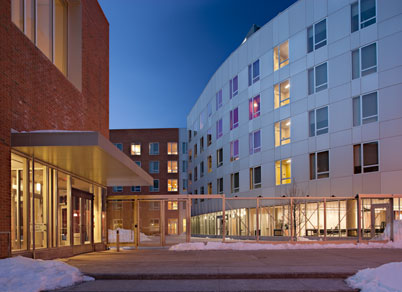Ashdown House
 |
    |
| Roll over photo thumbnails to change large image. | |
| Architect | William Rawn Associates, Architects, Inc. |
| Completed | 2008 |
| design features |
|
| Sustainable Design Elements |
|
| Awards | LEED-Gold certification from the U.S. Green Building Council, 2009—the first LEED-Gold building on campus. |
The residence hall includes 441 beds in a series of connected buildings that are three to five stories tall and are situated around two courtyards. The variety of room types available provide students with a wide range of living and financial options. The diversity of choices includes efficiencies, two-bedroom apartments, three-bedroom apartments, and three-bedroom suites without kitchens or living rooms.
In addition to the private and public spaces in the buildings, the area surrounding the complex is landscaped with spaces to create “greenscape” along Albany Street. The courtyards create a singular community and serve as private outdoor gardens for the graduate residents.
Project Team
| Project Managers/MIT | Gary Tondorff-Dick, AIA, LEED, Marty Deluga |
| design architect | William Rawn Associates, Architects, Inc. |
| M/E/P Engineers | Vanderweil Engineers |
| Structural engineers | LeMessurier Consultants |
| Landscape architect | Richard Burck Associates, Inc. |
| Sustainable Design | The Green Engineer |
| construction manager | Bovis Lend Lease |